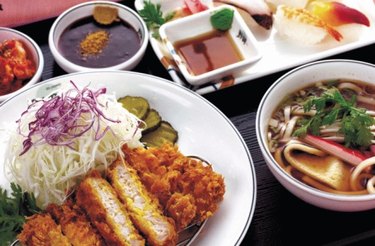
At first glance, teriyaki and soy sauce may appear to the same, however the two differ to a certain extent. Both have roots in Asia. Soy sauce takes on several variations throughout the world, whereas teriyaki sauce and the cooking technique of teriyaki is indigenous to Japanese cuisine.
Origins
Video of the Day
Tracing its origin back some 3,000 years, soy sauce is derived from jiang, the pickling of fish, game and salt in a pungent liquid for a three-month period of time. The meat in jiang was later substituted with a legume, soybeans. The Chinese created a style of soy sauce by adding wheat flour and yeast to soybeans and allowed the mixture to ferment in a salt-based liquid. Japanese for "glossy broil" or "glaze broiling," teriyaki originated as a method of grilling or broiling fish and meats, particularly chicken, lamb and beef in a liquid sauce. The sauce used in this form of cooking became known as teriyaki sauce.
Video of the Day
Identification
The soy sauce typically used in the United States has dark coloring and a loose, liquid consistency. Soy sauce, in its original Chinese state, has a lighter, opaque appearance. The thickness and coloring of teriyaki sauce varies per recipe or product. The addition of vegetables and other ingredients, such as honey may lighten a sauce's color, typically to an orange or copper tint. These additives also provide thickening to an otherwise watery consistency.
Uses
Teriayki sauce serves as a marinade for meat to soak in and absorb flavor and to tenderize. Pouring or basting the sauce over meat once it has cooked, or dipping the food in the sauce, are other uses of teriyaki sauce. Used primarily as a condiment or to season, soy sauce is an additive rather than a cooking agent.
Flavor
Soy sauce has a salty and sweet flavor. The wheat or rice (as in Japanese fermentation) adds a slightly sweet taste to the sauce. Indonesian soy sauce has two distinct varieties: the sweet kecap, mainly due to the addition of brown sugar, and kecap asin, which is salty. Primarily sweet in nature, teriyaki sauce consists of soy sauce. Japanese saké or mirin — a sweet, rice wine — typically combined with sugar or honey, lends to the sauce's syrupy taste. Other vegetables and spices, such as ginger and garlic contribute to teriyaki's savory flavor.